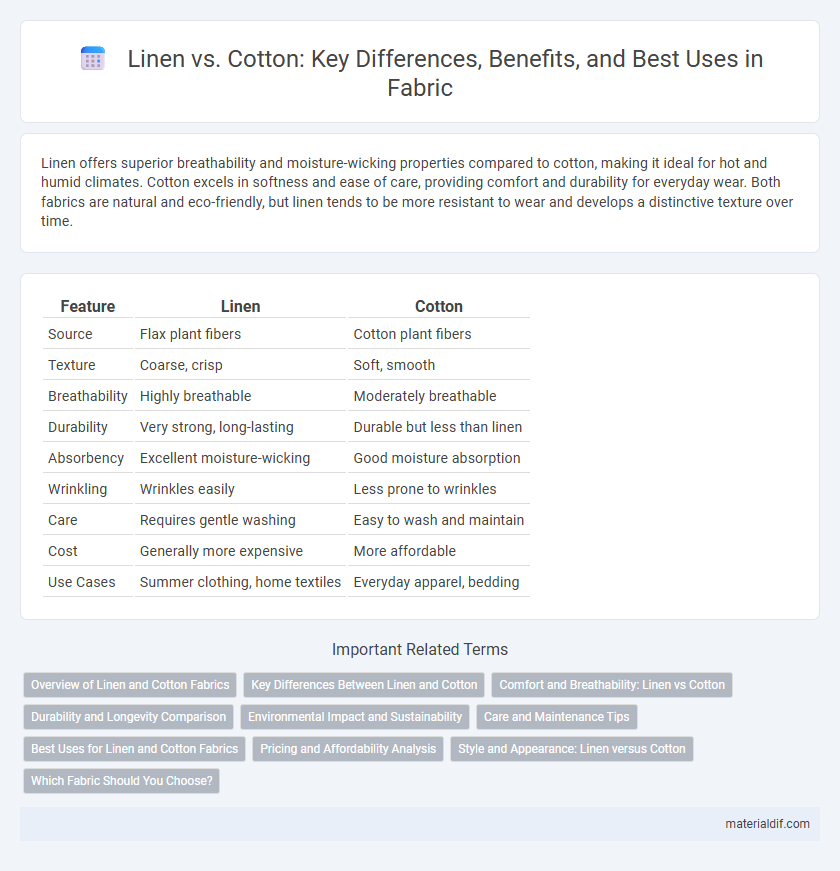Linen offers superior breathability and moisture-wicking properties compared to cotton, making it ideal for hot and humid climates. Cotton excels in softness and ease of care, providing comfort and durability for everyday wear. Both fabrics are natural and eco-friendly, but linen tends to be more resistant to wear and develops a distinctive texture over time.
Table of Comparison
| Feature | Linen | Cotton |
|---|---|---|
| Source | Flax plant fibers | Cotton plant fibers |
| Texture | Coarse, crisp | Soft, smooth |
| Breathability | Highly breathable | Moderately breathable |
| Durability | Very strong, long-lasting | Durable but less than linen |
| Absorbency | Excellent moisture-wicking | Good moisture absorption |
| Wrinkling | Wrinkles easily | Less prone to wrinkles |
| Care | Requires gentle washing | Easy to wash and maintain |
| Cost | Generally more expensive | More affordable |
| Use Cases | Summer clothing, home textiles | Everyday apparel, bedding |
Overview of Linen and Cotton Fabrics
Linen, derived from the flax plant, is renowned for its durability, breathability, and moisture-wicking properties, making it an ideal fabric for warm climates and summer clothing. Cotton, sourced from cotton plants, offers softness, versatility, and excellent absorbency, widely used in casual wear, bedding, and home textiles. Both fabrics are natural fibers, but linen typically has a coarser texture and higher strength compared to the smoother, more elastic nature of cotton.
Key Differences Between Linen and Cotton
Linen, derived from flax fibers, is known for its exceptional breathability, moisture-wicking properties, and natural durability, making it ideal for warm climates and long-lasting textiles. Cotton, sourced from cotton plants, offers softness, versatility, and a wide range of fabric weights, excelling in comfort and ease of care for everyday wear. Linen tends to wrinkle more easily but becomes softer with each wash, whereas cotton maintains a smoother appearance and provides greater elasticity.
Comfort and Breathability: Linen vs Cotton
Linen offers superior breathability compared to cotton due to its loosely woven fibers that allow better air circulation, keeping the body cooler in hot weather. Cotton provides excellent softness and moisture absorption, making it comfortable for everyday wear but less effective at releasing heat. Both fabrics are natural and breathable, but linen's textured weave enhances ventilation, making it ideal for hot and humid climates.
Durability and Longevity Comparison
Linen fabric is known for its exceptional durability, often outlasting cotton due to its strong flax fibers that resist wear and tear over time. Cotton, while softer initially, tends to degrade faster with frequent washing and exposure to sunlight, making linen a superior choice for long-lasting textiles. The natural strength and resistance to pilling of linen contribute to its reputation for longevity, especially in applications like upholstery and heavy-use clothing.
Environmental Impact and Sustainability
Linen, derived from flax plants, exhibits a lower environmental impact compared to cotton due to its minimal water consumption and reduced need for pesticides during cultivation. Cotton production typically demands extensive irrigation and heavy pesticide use, contributing to soil depletion and water scarcity issues. The biodegradability of linen fibers and the durability of linen fabric further enhance its sustainability credentials, making it a more eco-friendly choice for environmentally conscious consumers.
Care and Maintenance Tips
Linen requires gentle washing in cold or lukewarm water to preserve its natural fibers and prevent shrinkage, while cotton is more durable and can withstand higher temperatures during laundering. Avoid using harsh detergents or bleach on linen to maintain its texture and color, whereas cotton fabrics tolerate regular detergents and more frequent washing. Air drying is recommended for linen to reduce wrinkling and fabric wear, whereas cotton can be tumble-dried on low heat with minimal risk of damage.
Best Uses for Linen and Cotton Fabrics
Linen excels in hot and humid climates due to its superior breathability and moisture-wicking properties, making it ideal for summer clothing, bedding, and table linens. Cotton offers greater versatility and softness, suited for everyday apparel, casual wear, and home textiles like towels and bed sheets. Both fibers are durable, but linen is preferred for lightweight, crisp textures, while cotton is favored for comfort and ease of care.
Pricing and Affordability Analysis
Linen fabric generally commands a higher price than cotton due to its labor-intensive production process and durability, making it less affordable for budget-conscious consumers. Cotton, widely produced and more accessible, offers a broader range of price points suitable for various budgets without compromising comfort. The cost-efficiency of cotton coincides with its versatility, while linen's premium pricing reflects its luxury status and long-lasting quality.
Style and Appearance: Linen versus Cotton
Linen fabric showcases a distinct texture with a slightly coarse, natural look that softens over time, offering a rustic, elegant style ideal for casual and formal wear. Cotton boasts a smooth surface and vibrant color retention, providing a versatile, polished appearance suitable for a wide range of fashion applications. The breathable, lightweight nature of both fabrics influences their drape and fit, with linen lending a more relaxed, breathable silhouette and cotton delivering a structured, crisp finish.
Which Fabric Should You Choose?
Linen offers superior breathability and moisture-wicking properties, making it ideal for hot, humid climates, while cotton provides a softer texture and better elasticity, suitable for everyday wear and easy care. Linen is more durable and gets softer with each wash, although it wrinkles easily, whereas cotton is more resistant to wrinkles and maintains shape well over time. Your choice should depend on personal comfort preferences, climate, and garment use, with linen excelling in cooling and cotton favored for versatility and softness.
Linen vs Cotton Infographic

 materialdif.com
materialdif.com